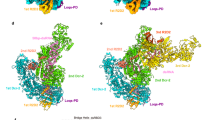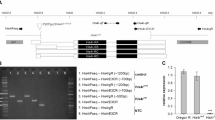Abstract
Heat-shock proteins (Hsps) are molecular chaperones that control protein folding and function. Argonaute 2 (Ago2), the effector in RNA interference (RNAi), is associated with Hsp90; however, its function in RNAi remains elusive. Here we show that Hsp90 is required for Ago2 to receive the small interfering RNA (siRNA) duplex from the RNA-induced silencing complex–loading complex in RNAi, suggesting a model where Hsp90 modifies Ago2 conformation to accommodate the siRNA duplex.
This is a preview of subscription content, access via your institution
Access options
Subscribe to this journal
Receive 12 print issues and online access
$189.00 per year
only $15.75 per issue
Buy this article
- Purchase on Springer Link
- Instant access to full article PDF
Prices may be subject to local taxes which are calculated during checkout


Similar content being viewed by others
Change history
25 August 2010
In the version of this article initially published, “2′-O-methyl group at the 10th nucleotide” should have read “2′-O-methyl groups at the 9th and 10th nucleotides.” The error has been corrected in the HTML and PDF versions of the article.
References
Siomi, H. & Siomi, M.C. Nature 457, 396–404 (2009).
Kim, V.N., Han, J. & Siomi, M.C. Nat. Rev. Mol. Cell Biol. 10, 126–139 (2009).
Kawamata, T. & Tomari, Y. Trends Biochem. Sci. 35, 368–376 (2010).
Yoda, M. et al. Nat. Struct. Mol. Biol. 17, 17–23 (2010).
Miyoshi, K., Tsukumo, H., Nagami, T., Siomi, H. & Siomi, M.C. Genes Dev. 19, 2837–2848 (2005).
Matranga, C., Tomari, Y., Shin, C., Bartel, D.P. & Zamore, P.D. Cell 123, 607–620 (2005).
Rivas, F.V. et al. Nat. Struct. Mol. Biol. 12, 340–349 (2005).
Liu, J. et al. Science 305, 1437–1441 (2004).
Maniataki, E. & Mourelatos, Z. Genes Dev. 19, 2979–2990 (2005).
Höck, J. et al. EMBO Rep. 8, 1052–1060 (2007).
Landthaler, M. et al. RNA 14, 2580–2596 (2008).
Johnston, M., Geoffroy, M.C., Sobala, A., Hay, R. & Hutvagner, G. Mol. Biol. Cell 21, 1462–1469 (2010).
Tahbaz, N., Carmichael, J.B. & Hobman, T.C. J. Biol. Chem. 276, 43294–43299 (2001).
Smith, D.F. et al. Mol. Cell. Biol. 15, 6804–6812 (1995).
Pare, J.M. et al. Mol. Biol. Cell 20, 3273–3284 (2009).
Tahbaz, N. et al. EMBO Rep. 5, 189–194 (2004).
Tomari, Y., Matranga, C., Haley, B., Martinez, N. & Zamore, P.D. Science 306, 1377–1380 (2004).
Tomari, Y. et al. Cell 116, 831–841 (2004).
Wang, Y. et al. Nature 456, 921–926 (2008).
Roe, S.M. et al. J. Med. Chem. 42, 260–266 (1999).
Acknowledgements
We thank K. Miyoshi and T. Yoshihisa for providing technical advice and other members of the Siomi laboratory for discussions. This work was supported by Ministry of Education, Culture, Sports, Science and Technology of Japan grants to H.S. and M.C.S. M.C.S. is supported by Core Research for Evolutional Science and Technology from the Japan Science and Technology Agency.
Author information
Authors and Affiliations
Contributions
T.M. and A.T. conducted experiments; T.M., A.T., H.S. and M.C.S. designed experiments, interpreted data and prepared the manuscript.
Corresponding author
Ethics declarations
Competing interests
The authors declare no competing financial interests.
Supplementary information
Supplementary Text and Figures
Supplementary Methods and Supplementary Figure 1 (PDF 1228 kb)
Rights and permissions
About this article
Cite this article
Miyoshi, T., Takeuchi, A., Siomi, H. et al. A direct role for Hsp90 in pre-RISC formation in Drosophila. Nat Struct Mol Biol 17, 1024–1026 (2010). https://doi.org/10.1038/nsmb.1875
Received:
Accepted:
Published:
Issue Date:
DOI: https://doi.org/10.1038/nsmb.1875
This article is cited by
-
Does the Global Outbreak of COVID-19 or Other Viral Diseases Threaten the Stem Cell Reservoir Inside the Body?
Stem Cell Reviews and Reports (2021)
-
Regulation of microRNA biogenesis and its crosstalk with other cellular pathways
Nature Reviews Molecular Cell Biology (2019)
-
Dual regulation of Arabidopsis AGO2 by arginine methylation
Nature Communications (2019)
-
Over-expression of Hsp83 in grossly depleted hsrω lncRNA background causes synthetic lethality and l(2)gl phenocopy in Drosophila
Journal of Biosciences (2019)
-
How does Hsp90 function in RNAi-dependent heterochromatin assembly?
Current Genetics (2019)



